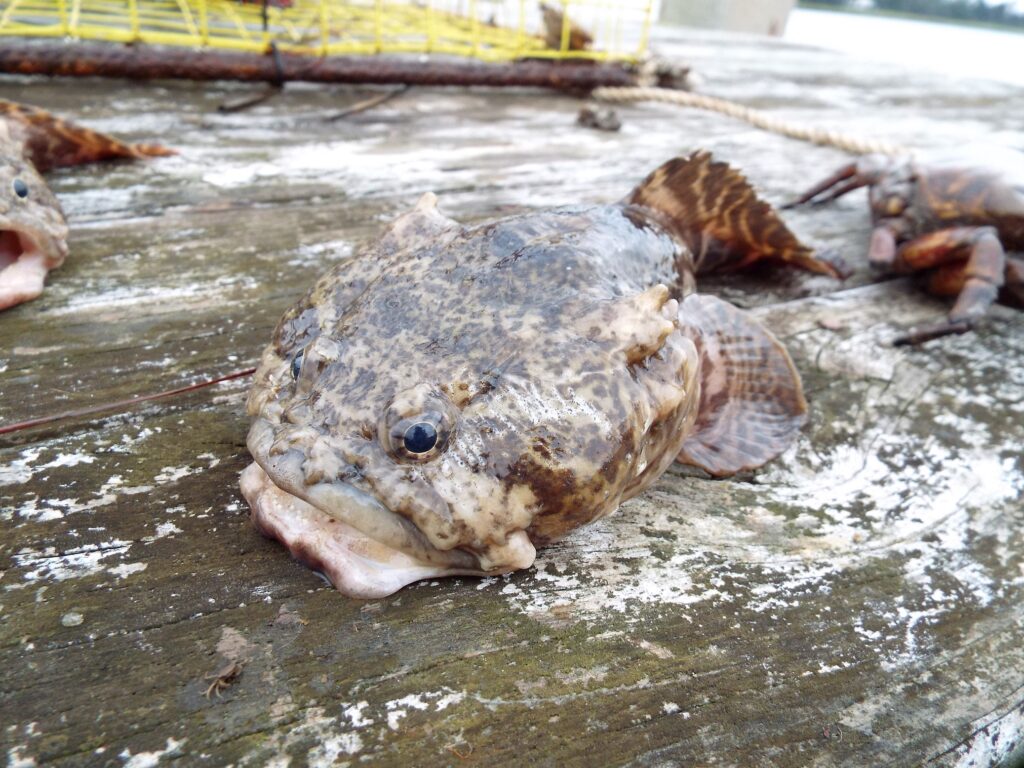
This week for Flora and Fauna Friday we’ve dredged up a peculiar fish from our estuarine waterways, the Oyster Toadfish (Opsanus tau).
The Oyster Toadfish is found throughout the saline coastal of coastal South Carolina. It’s most commonly seen in and around oyster reefs where it nestles between the oysters and the pluff mud, lying in ambush. They’re omnivorous but mainly eat crustaceans, mollusks, and small fish. The Oyster Toadfish is a strange and unique looking fish. It reaches about a foot in length and its relatively flat body is covered in a mottled pattern of browns and pale-yellow. Their pectoral fins are heavy and muscular and their dorsal fin extends all the way down towards the end of their tail, perfect for crawling around the mud and low-speed swimming. They have a broad, flat head covered in fleshy barbels and a wide mouth full of small dome-shaped teeth. When pulled out of the water, Oyster Toadfish can be a handful. These fish grunt, bite, and wield a mildly venomous dorsal spine. Their sting is painful like a wasp but otherwise harmless. The Oyster Toadfish is one of the many species who depend on the critical inshore reef habitat created by the Eastern Oyster and a key part of keeping those habitats healthy.
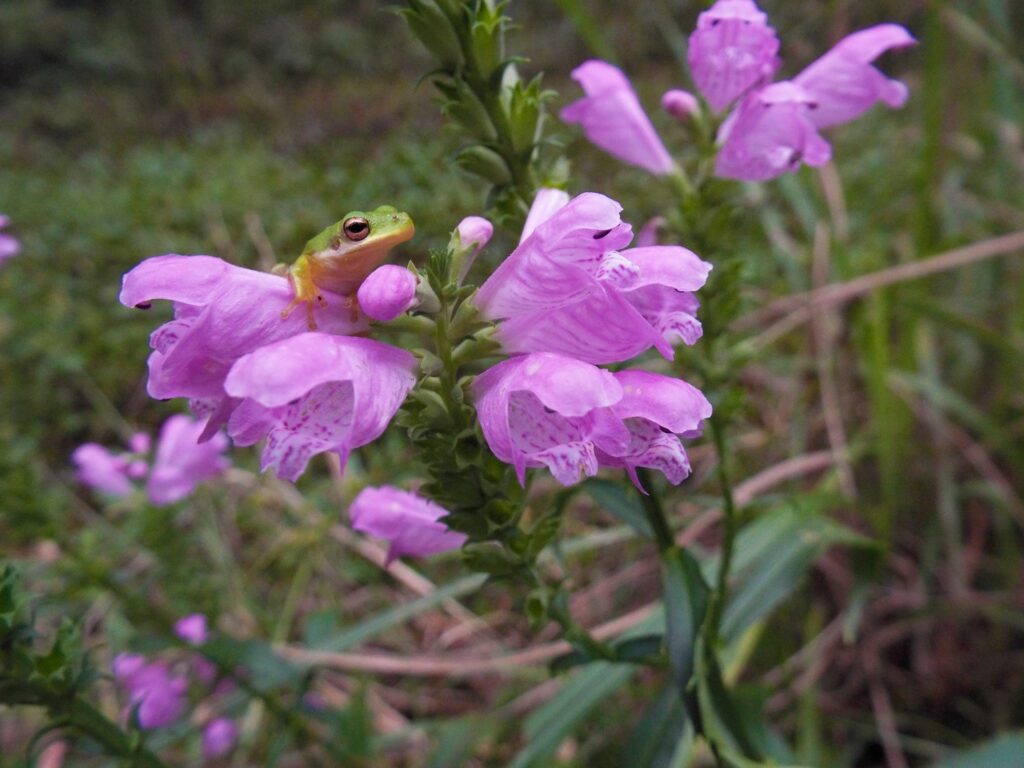
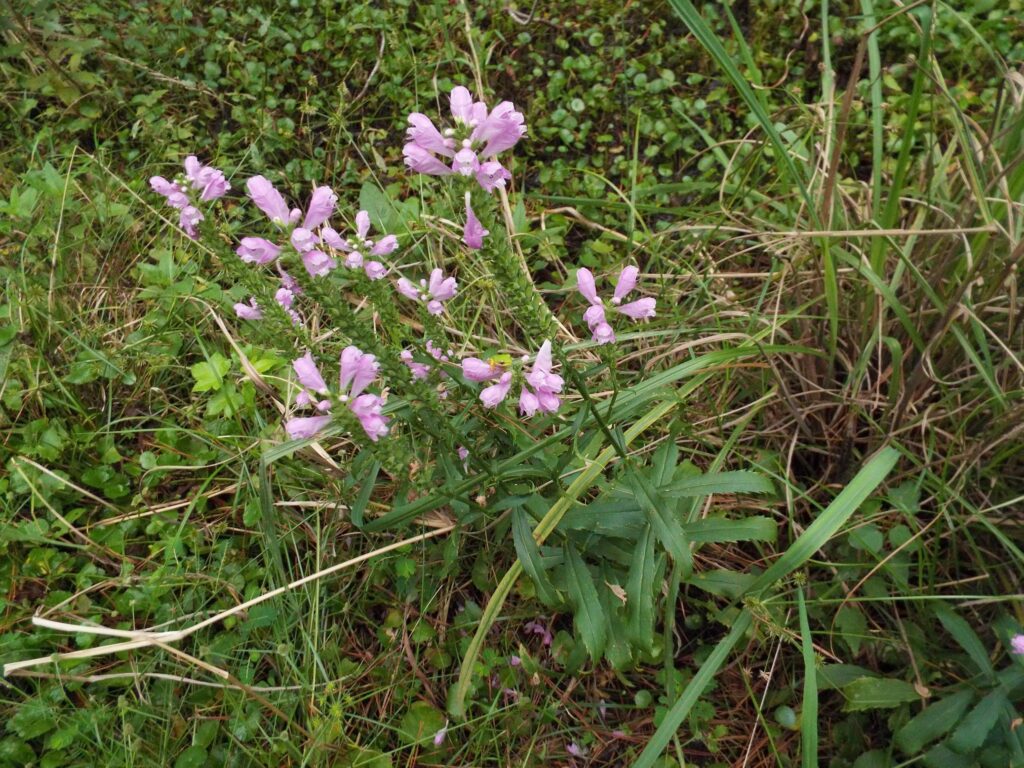
This week for Flora and Fauna Friday we have yet another noticeable wetland wildflower, Obedient Plant (Physostegia virginiana).
Obedient Plant is found sporadically within the South Carolina Lowcountry. It’s not a particularly common native wildflower here but it is a widespread staple of home gardens and easy to source at native plant nurseries. It prefers wet meadows, freshwater marsh margins, and sunny floodplains, all not too common habitats here in South Carolina. Obedient Plant grows two to three feet in height. It spreads laterally beneath the ground and forms loose clumping colonies. It has an upright posture with stems growing straight up, branches held aloft, and leaves held straight out. The leaves are oppositely arranged and easily identified by their simple, elliptical shape and saw-toothed margins. Obedient Plant is in the mint family, Lamiaceae, and proudly demonstrates its family’s trademark square stems. Yet its flowers are still the trademark identifier. Flowers bloom at the uppermost tips of the stems and branches. Individual flowers are arranged together into a spike, with each flower emerging directly from the stem, and together the flower buds form a tall and tight-knit spire above the main plant. Individual flowers bloom from the base of the spike upward. There are often a dozen or more open at once, all packed closely together. Each flower is a blend of magenta and white, giving the flower a pale pink color from a distance. The petals of each flower are fused together into a bilaterally symmetrical corolla, shaped a bit like a pitcher. The peak bloom time of Obedient Plant is mid-September and it is a wonderful nectar plant for pollinators, particularly our native bees. It’s also a good addition to any backyard garden and grows well in garden beds with rich, moist soils.
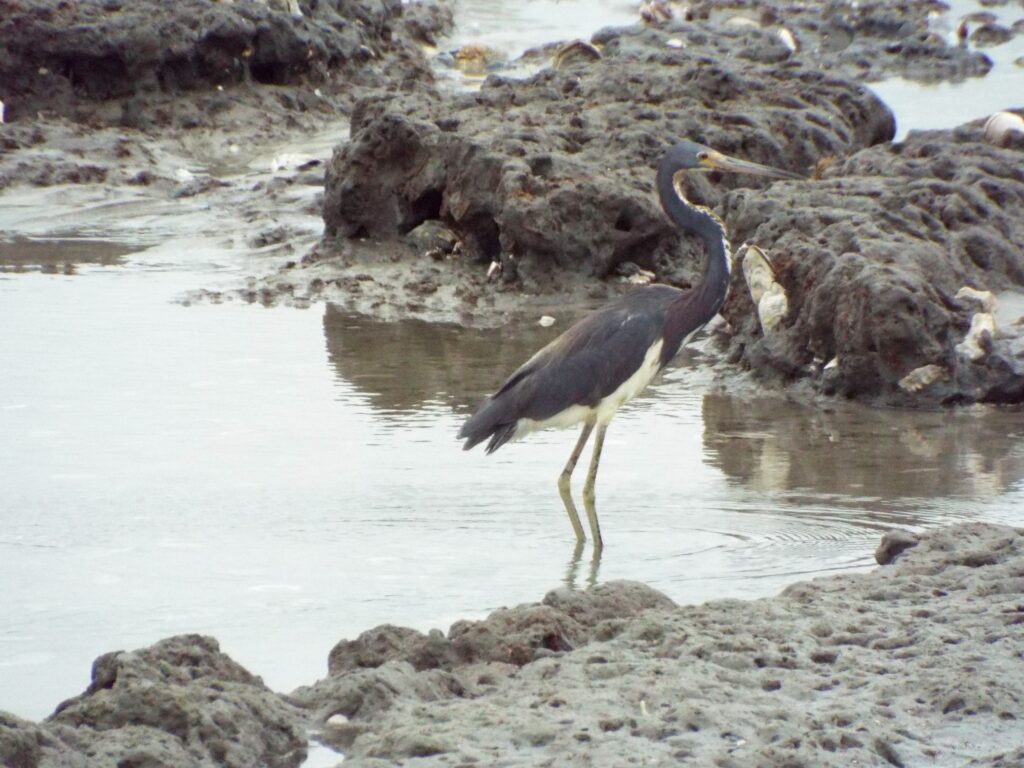
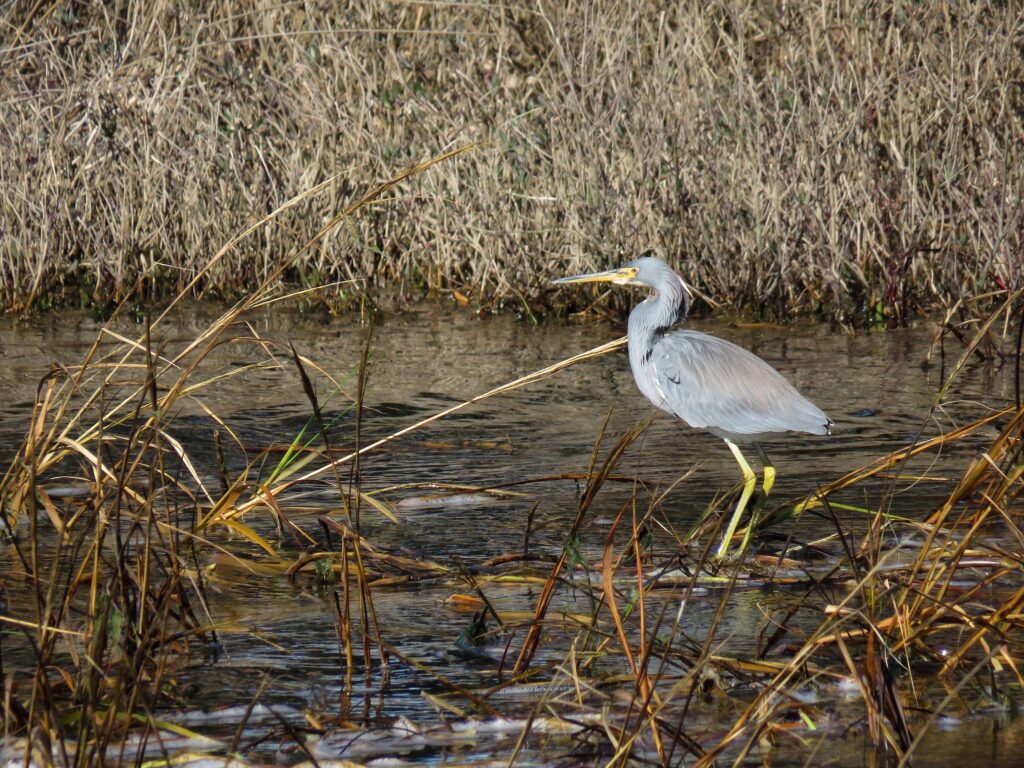

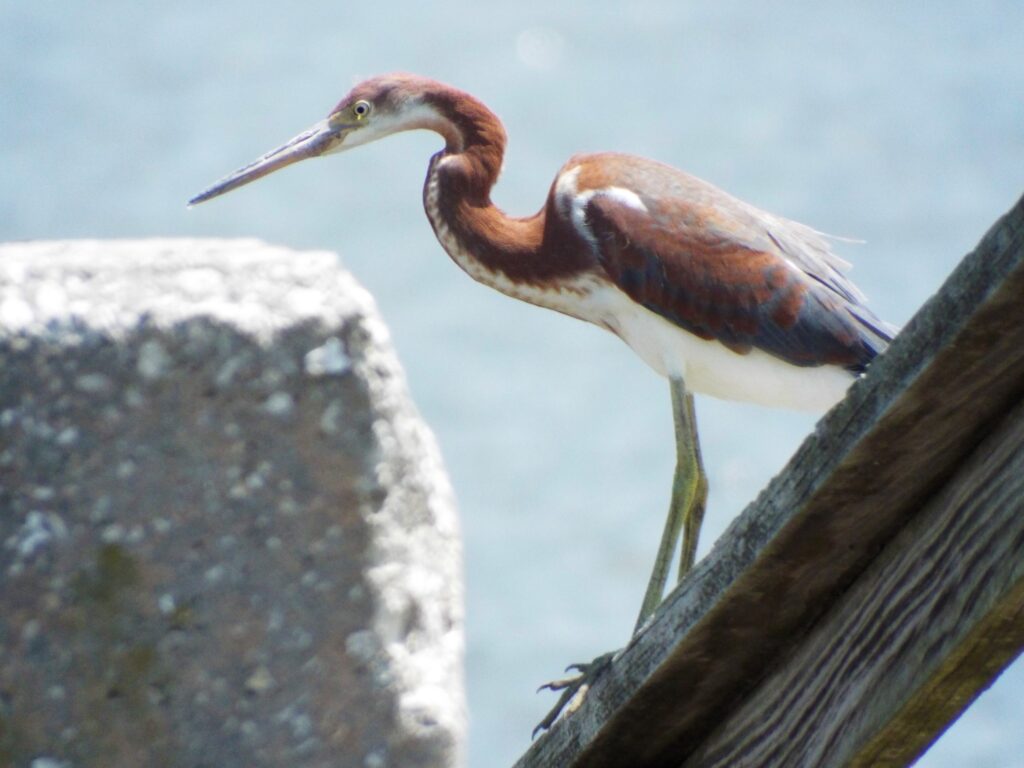
This week for Flora and Fauna Friday we’re scoping out the Tricolored Heron (Egretta tricolor).
The Tricolored Heron is a large bird and a medium-large Heron. It’s found year-round throughout the South Carolina Lowcountry as well as the coastal plain of the Eastern United States, from Massachusetts down into Mexico, and beyond. The Tricolored Heron is one of our more colorful herons and is plumed with white across the belly and underwings, a pewter-blue across the back, wings, and neck, and a frayed string of chestnut-brown between their throat and their breastbone. That chestnut returns again, blended into the pewter of the mantle and mane, which are adorned with longer plume-like feathers on adult birds. Juveniles lack these plumes in exchange for heavy chestnut accents along their flanks and all the way up their neck. In the off-season, adults have chartreuse-yellow legs and a dark crimson-red eye behind a patch of golden-yellow skin. In breeding plumage, adults gain white plumes from the back of their head, rosy legs, an intense scarlet eye, and a brilliant sky-blue beak. Like all our Egrets and Herons, Tricolored Herons hunt fish using their long necks, pointed bills, and high-speed pinpoint precision. Tricolored Herons are more active than some of our waders and can often be seen walking slowly through shallow water or sometimes running and chasing fish in very shallow pools. Again like other waders, they are colony nesters and make use of tall-shrubs and low-hanging branches in open swamps over alligator-filled waters, usually alongside several other species of wading birds.
Here’s a quick fun fact. The terms Egret and Heron don’t truly have a deeper scientific meaning. Even though we have a standardized set of common names for bird species, their use is arbitrary and inconsistent. One could argue that members of the genus Ardea are the true Herons and members of Egretta the true Egrets but it is all semantics. Members of one are called the other and we have several other genera that are labelled as one or the other. For example, the Great Blue Heron and Great Egret are both in genus Ardea and at the same time the Snowy Egret is in genus Egretta but so is the Tricolored Heron. We also have the Green Heron, which is a separate genus, and the Cattle Egret, yet another genus. What it all boils down to is that Egrets are pure white in color and Herons are not. Except for the ones that aren’t, like the Little Blue Heron that is snow-white as a juvenile but ocean-blue and faded maroon as an adult. Makes sense given the adult isn’t white. However, the Reddish Egret is also snow-white as a juvenile but becomes faded clay-red and storm-gray as an adult. I guess the most we can say with certainty is all Egrets are all white in at least one stage of their life. (The most used term in applied biology is “it depends” and, as I like to say, “biology is the study of exceptions.”)
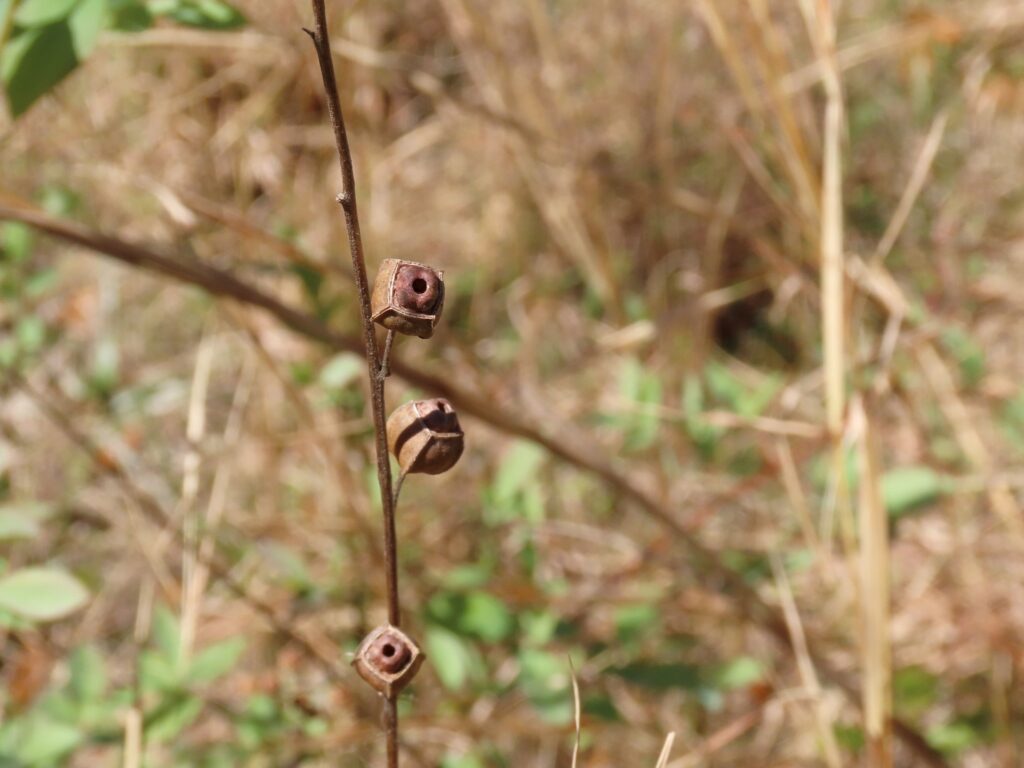
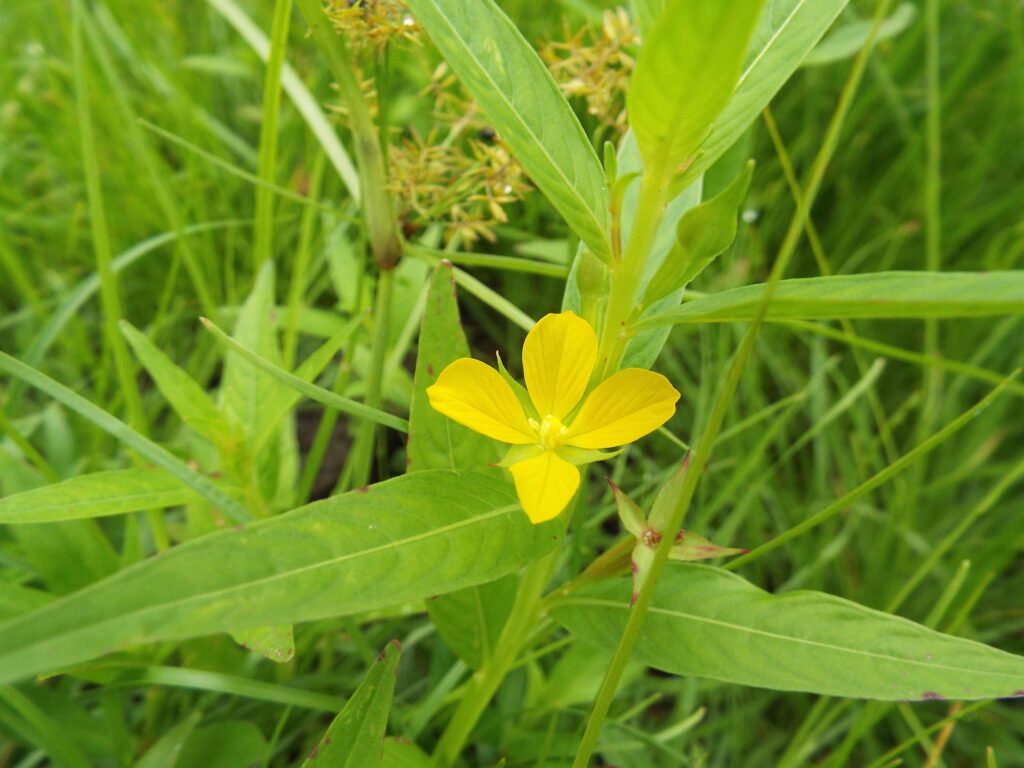
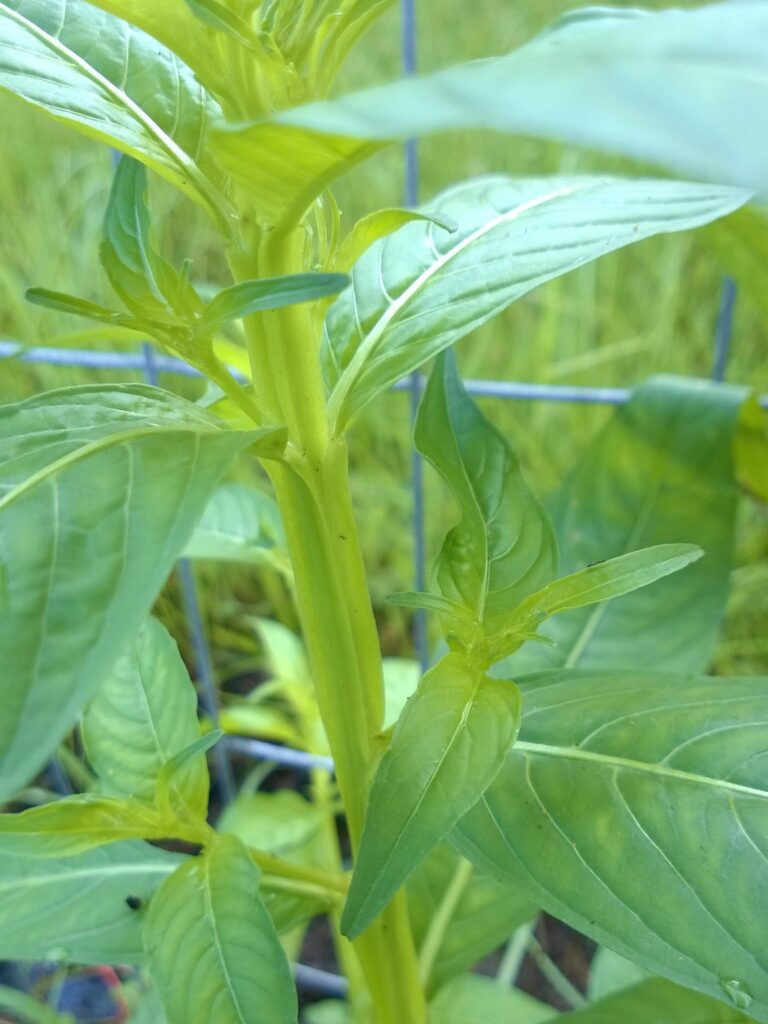
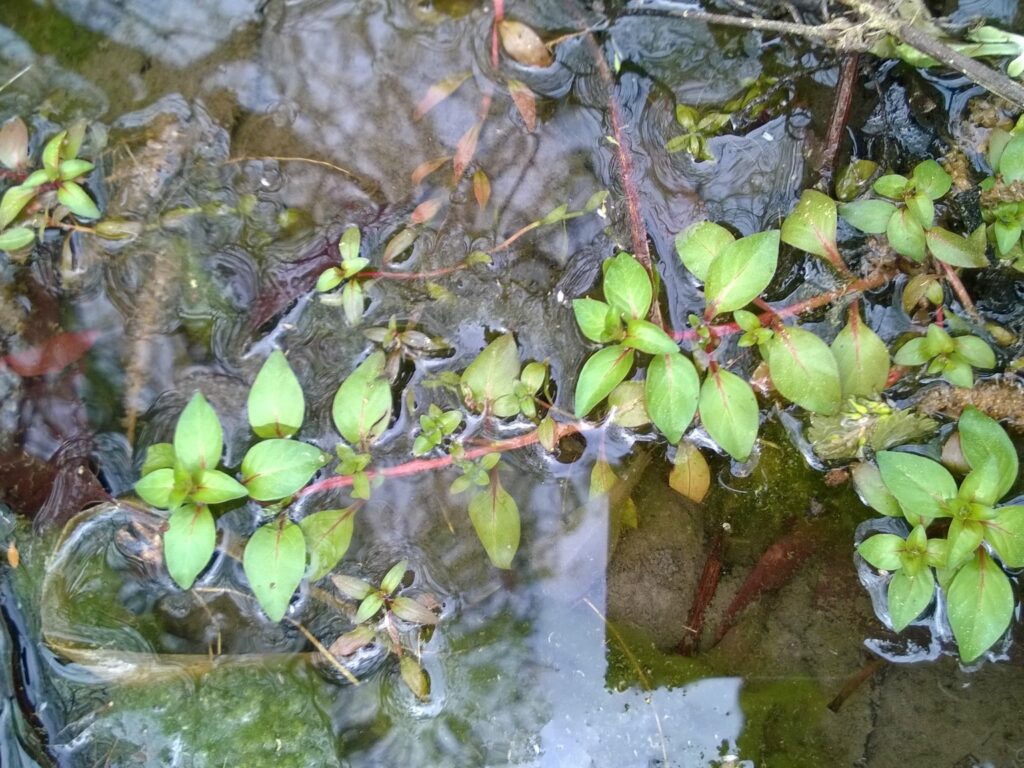
This week for Flora and Fauna Friday, we have a common denizen of ditches and pond edges, the Primrose-Willows of genus Ludwigia.
Primrose-Willows, AKA Water-Primroses, are a group of predominantly small wetland shrubs which are widespread throughout the Eastern United States. In South Carolina we have roughly sixteen abundant species. I’m going to focus on the three I think you’ll be most likely to see: Seedbox (L. alternifolia), Wingleaf Primrose-Willow (L. decurrens), and Water-Purslane (L. palustris).
Seedbox is often found in sunny ditches, pond edges, and freshwater marshes. It grows about three feet in height and forms small, airy bushes. It has a narrow, smooth stem that is often reddish in color. Its leaves are alternate and simple, pointed, and elongate with a pale vein down the center. The flower is four-petalled and lemon-yellow with nearly heart-shaped petals. The calyx of leaves beneath the petals is practically square on its perimeter, with its points situated between the petals. The most distinctive feature of Seedbox, and where it gets that common name, is its dry capsule fruit. This capsule takes on an almost cubic shape, with a square top and seams between its gently bowing sides.
Wingleaf Primrose-Willow is superficially similar to Seedbox in size and shape and is found in much the same habitats. However, Wingleaf Primrose-Willow prefers wetter feet and can grow in more saturated soils. It also grows straighter and less like a bush, its leaves have a corrugated character, and its stems are thicker, green, and often have wings running down from each leaf. The fruit of Wingleaf Primrose-Willow is very different in appearance from Seedbox, having an elongated rectangular shape and prominent ridges at each corner.
Water-Purslane is very different than the other two. It commonly grows as a creeping groundcover on pond and freshwater marsh edges but also as an emergent wetland plant in shallow water. It has somewhat spoon-shaped, alternate leaves often with a prominent pinkish-red vein and fleshy, burgundy stems. Its flowers are tiny and butter-yellow with petals shaped similarly to its leaves.

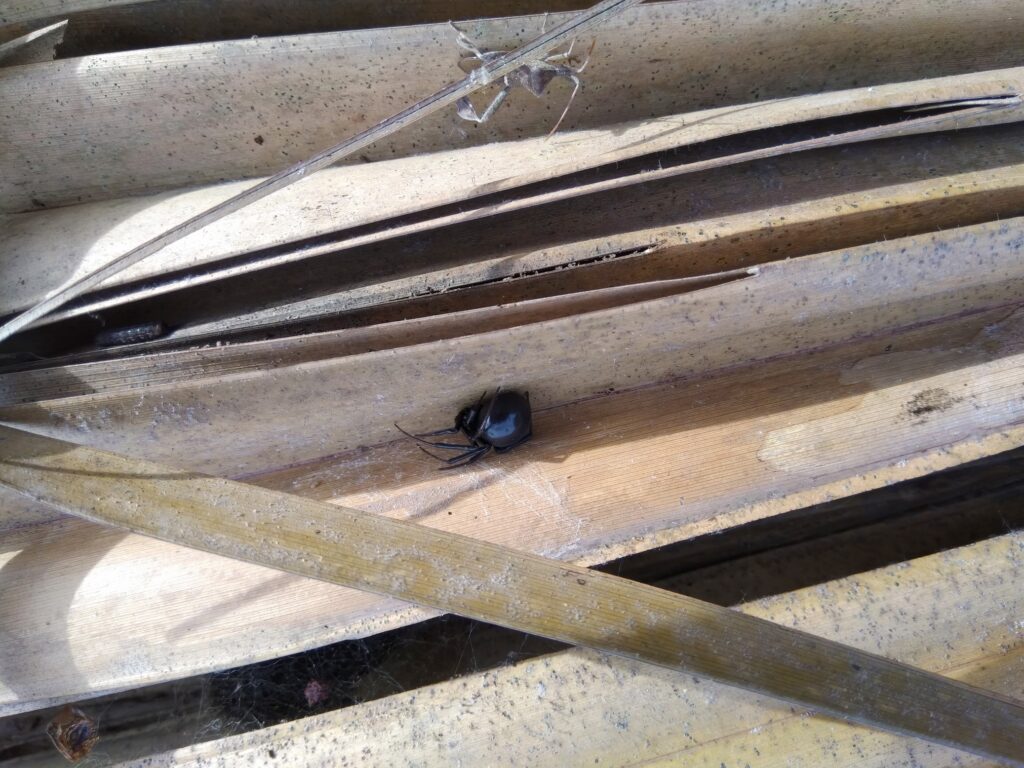
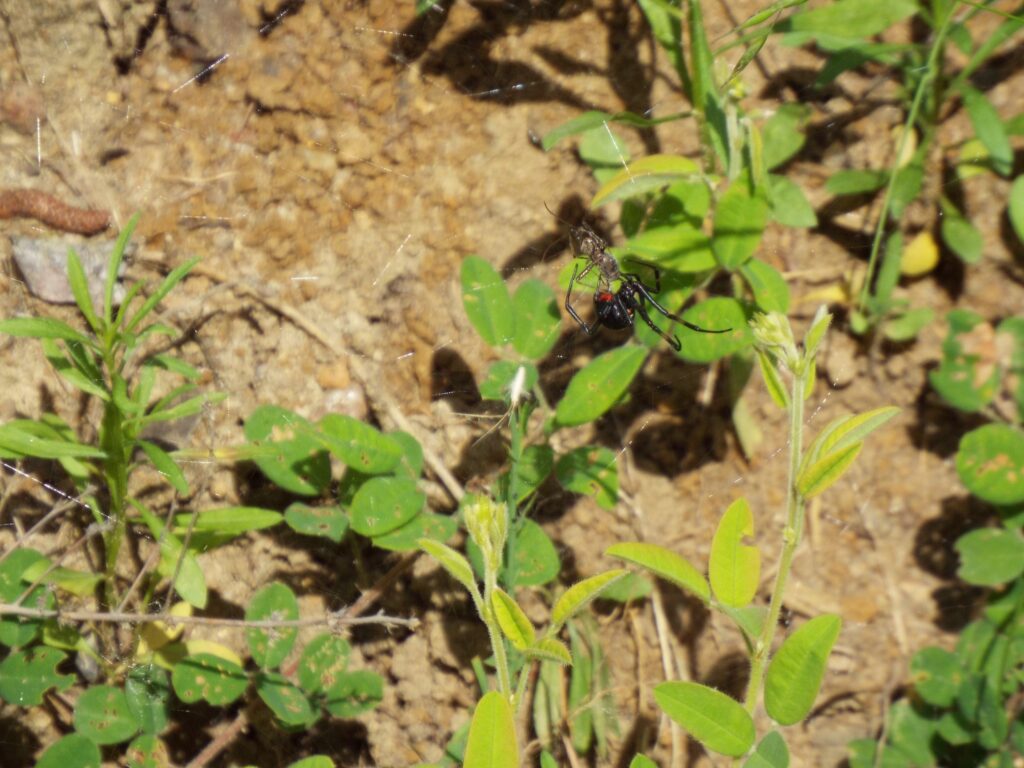

This week for Flora and Fauna Friday it’s the most feared arthropod in all the south, the Southern Black Widow (Latrodectus mactans).
The Southern Black Widow is a member of the Cobweb Spiders, family Theridiidae, and the Widow Spiders are the largest members of this family. They are found throughout the Lowcountry. An adult female Black Widow is usually about an inch-and-a-half in spread with a body about a half-inch long. The female Black Widow has a spherical abdomen, round cephalothorax (head plus thorax), and slim, almost hairless legs. They are usually a glossy ink-black across their entire body with a distinctive scarlet hourglass on the bottom of the abdomen and a scarlet-red spot just above their spinneret. Males are roughly half the size of the female with a wrinkly egg-shaped abdomen not much bigger than their cephalothorax. Males are also more colorful with tan and black banded legs and ivory and orange markings across the back, while still retaining the hourglass below. Immature females resemble the colorations of an adult male but with feminine proportions. Black Widows are found in open wooded areas and prefer to make their webs in drier locations and hidden from view. In the wild they make webs in bushes, thickets, brush piles, crevices, burrows, and hollow stumps. However, they have an affinity for web building in and under human structures, such as sheds, wood stacks, piles of rubble or masonry blocks, and crawl spaces. Their webs are thin, three-dimensional, and disorganized. The egg-sac of the South Black Widow is a roughly half-inch diameter sphere of tan, tightly wound silk.
Black Widows are well known, apart from their hourglass mark, for two things: their mating habits and their venom. Female Black Widows are reported to be voracious hunters of their own suitors, which earned them the Widow common name. Although it is true that they will not shy away from dining on their dates, more recent studies indicate that impromptu dinner dates are more a function of how well fed she is and how long the male sticks around than any habitual or instinctive preference of female Widows, with most males escaping unharmed. Moving to their other trademark, the venom of the Southern Black Widow is neurotoxic and causes incredibly painful, involuntary muscle spasms that spread from the site of the bite. These spasms can prevent breathing and cause death by suffocation. However, the dangers of a Black Widow bite have also been exaggerated. Although Black Widow venom is irrefutably capable of killing an adult human at the right dosage, it is difficult for the spider to inject that much venom to the right area of the body in a single bite. Unless the victim has underlying pre-existing conditions, the quantity of venom injected by a bite is very rarely enough to be fatal and symptoms take hours to manifest. However, that does not mean a Black Widow bite is not excruciatingly painful nor medically serious. Anyone bitten by a Black Widow should still seek immediate medical attention, just know it’s by no means a guaranteed sentence.
As a bonus, we also have another common species of Widow, the Brown Widow (L. geometricus). The Brown Widow is much the same size and shape with similar habits to the Southern Black Widow but, it is brown. It’s also covered in fuzz and can have a pale marbling pattern across the abdomen. Another notable difference between the two is the egg-sac. The Brown Widow’s egg-sac is spiked, giving it a somewhat woolen appearance and making it very easy to identify. The Brown Widow is not native to the Southeastern United States. It was introduced to Florida and spread north over time. It is now found throughout the coastal regions of Georgia and South Carolina. Brown Widows are found in the tropics worldwide and need hot, humid climates. They have a marked preference for human structures but, thankfully, their bite is far less potent than our native species, but still quite painful. The Northern Black Widow (L. variolus) is a third Widow species that can be found in South Carolina and it is very similar in appearance to the Southern. However, it is not nearly as common as the other two species down here on the coast.
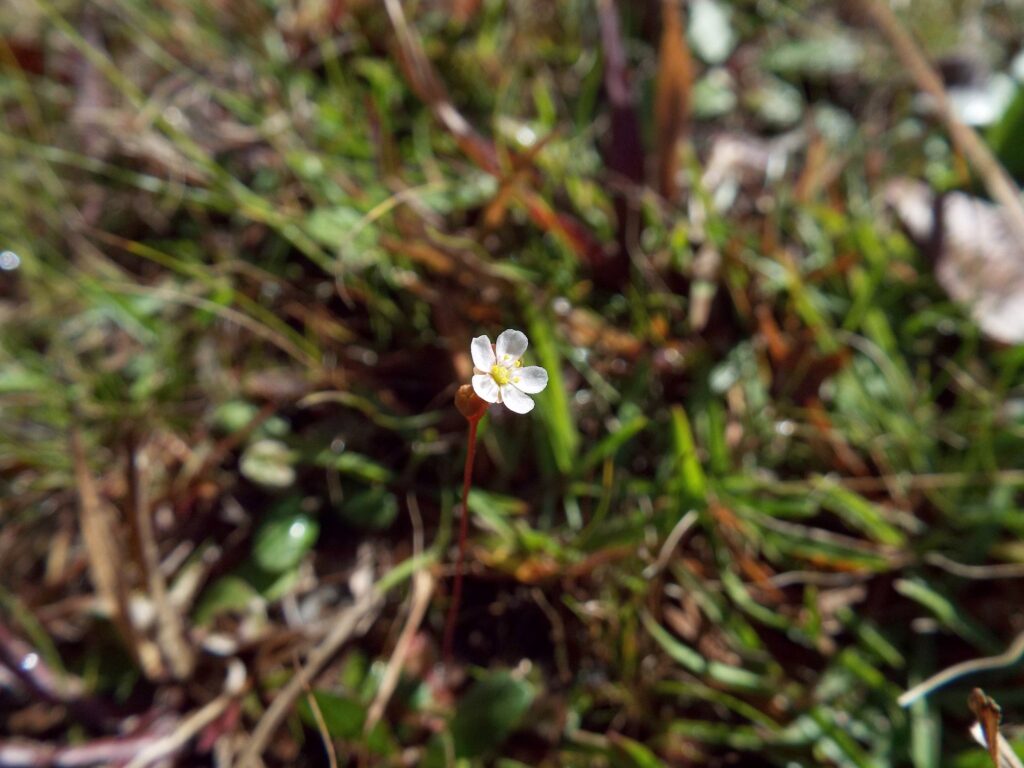
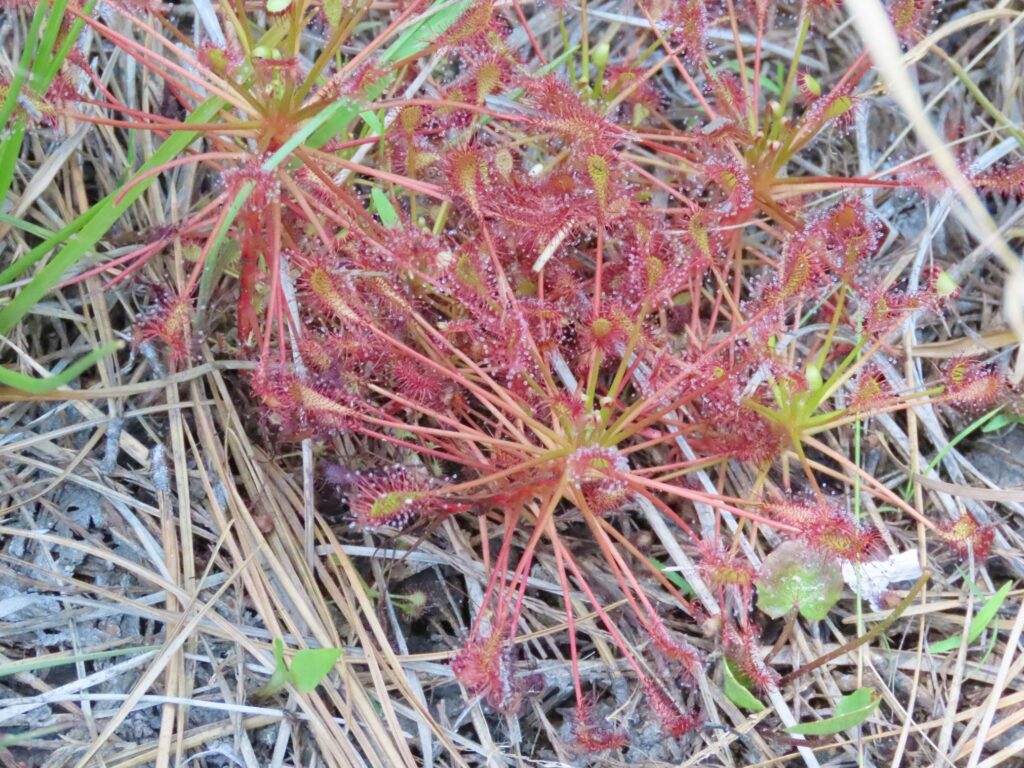
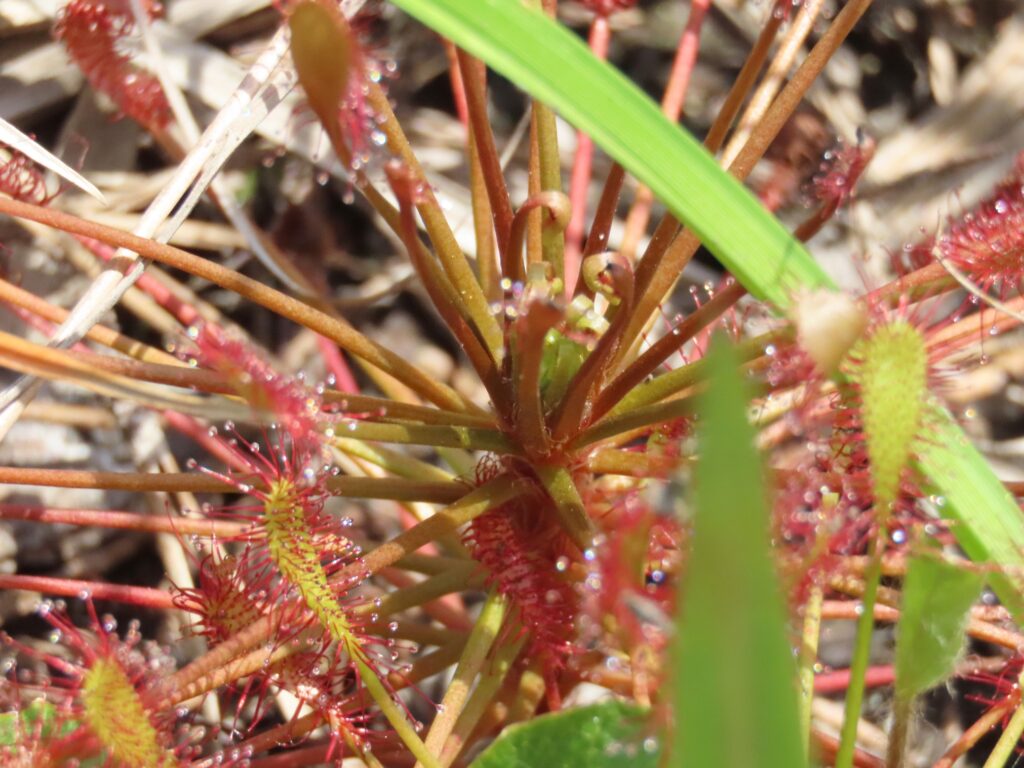
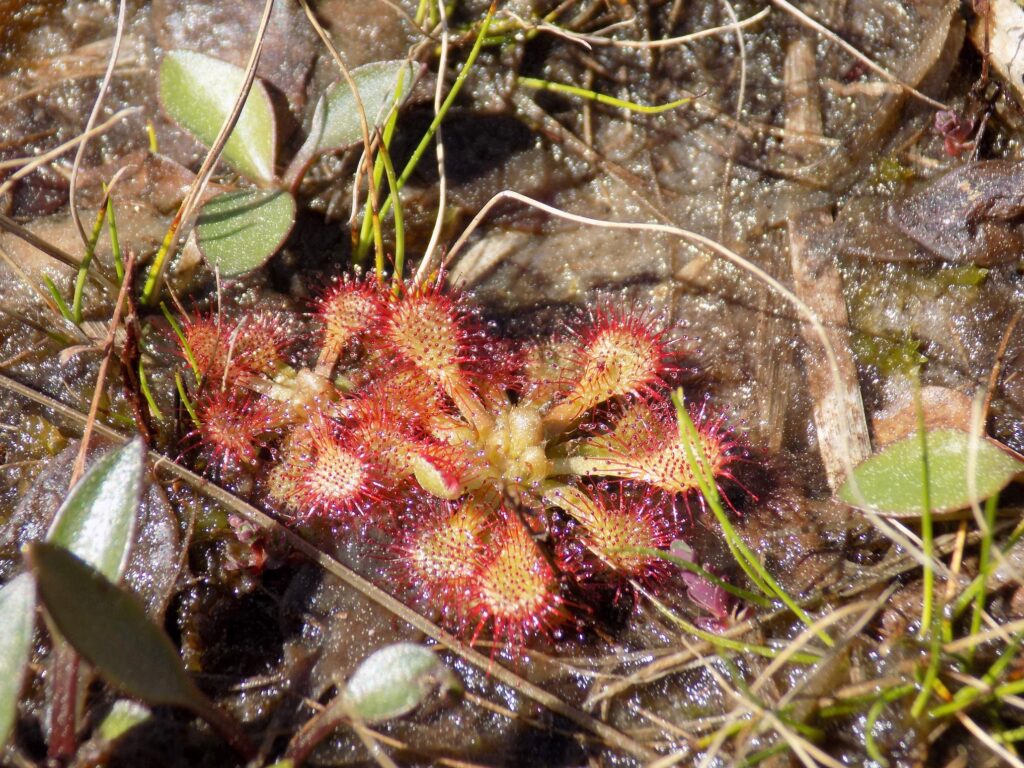
This week for Flora and Fauna Friday, it’s a small, sticky, bug-eating set of plants: the Sundews of genus Drosera.
Sundews are one of our more common groups of carnivorous plants but are still not all that easy to find. We have three widespread species of Sundew in South Carolina: Pink Sundew (Drosera capillaris), Spoon-leaved Sundew (D. intermedia), and Dwarf Sundew (D. brevifolia). All sundews prefer bare, sandy soils with plenty of moisture and are almost always encountered in Longleaf Pine savannas, flatwoods, the margins of carolina bays, and other fire-adapted habitats with adequate soils. They grow low to the ground as a rosette and are less than three-inches in diameter. Their bloom time peaks in early to mid-spring and their small, pale, five-petalled flowers appear atop long narrow stalks. Sundews can be either perennial or annual, depending on environmental conditions throughout the year. This genus is an easy one to identify here in the Lowcountry as all of our species share unique physical characteristics. Sundews have chartreuse and rosy-scarlet foliage with leaves that are spoon-shaped and covered in thick scarlet hairs. The means by which Sundews capture and eat insects is found on those scarlet hairs. The tip of each hair produces a tiny droplet of crystal clear liquid, like dew drops in the morning sun. This fluid is sweet smelling and attracts flies, ants, and other minute insects. When an insect lands on the leaf, the droplets adhere to it like glue, sticking it to the plant. Contact with prey also signals the leaf to cup or roll around the critter, increasing the number of hairs that make contact. The plant will then secrete digestive fluids through the ends of the hair and absorb the nutritious bug bits through the surface of the leaf.
Pink Sundew is probably the most common species in our area and needs wet sandy soil to survive. It is fairly small, usually only an inch or inch-and-a-half in width and with short leaves shaped like a wooden spoon. Its bloom time peaks throughout April and its flower is small and pale pink. Pink Sundew is perennial.
Spoon-leaved Sundew is most commonly found in acidic ephemeral wetlands and likely the hardest of today’s three to find. However, it’s certainly the easiest to identify. Spoon-leaved Sundew is much larger in size, at around two to three-inches in diameter, with long, narrow, oar-shaped leaves. The plant is a perennial, has a more three-dimensional globe-shape, and also grows taller over time but does not stay upright. Its flower is white and small relative to the size of the whole plant and its bloom time peaks in May and again in August.
Dwarf Sundew is the smallest of our Sundews but also the least habitat specific. It is similar in appearance to the Pink Sundew and prefers similar habitats but will tolerate drier soils. Dwarf Sundew grows to only about half-an-inch in diameter, stays flat to the ground, and has more teardrop-shaped leaves with hairs down to the bud. Its bloom time peaks between the end of March and early April and it does not have a secondary bloom period. The flower of Dwarf Sundew is white and, relative to the size of the plant, is quite large compared to our other two species.
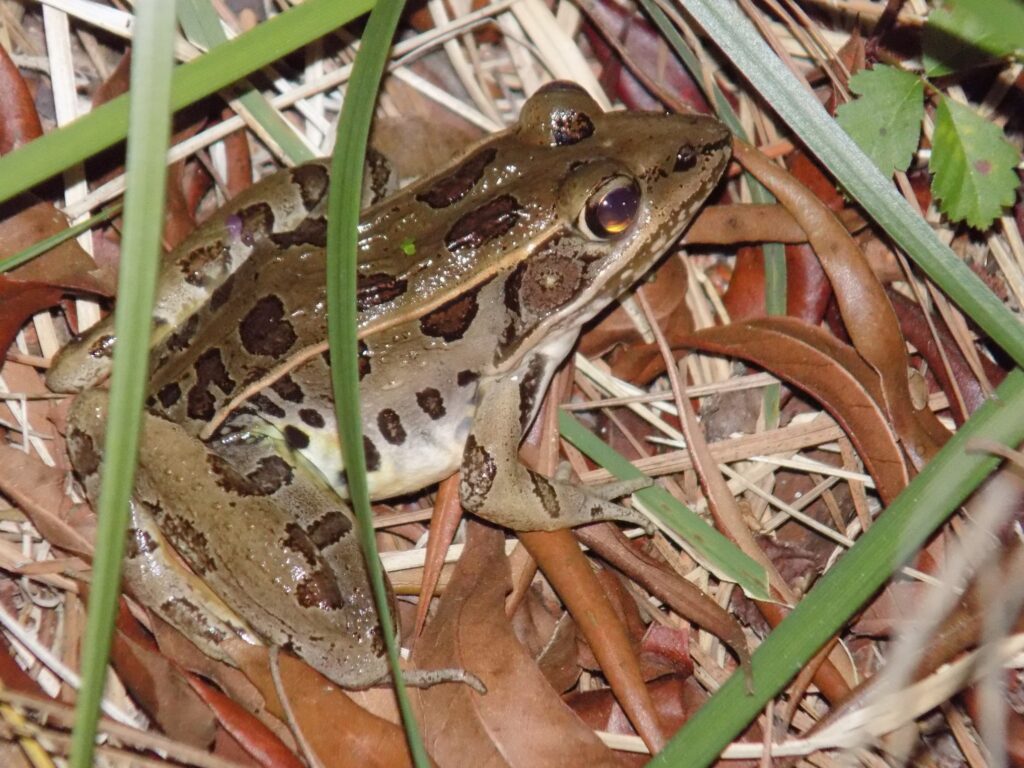
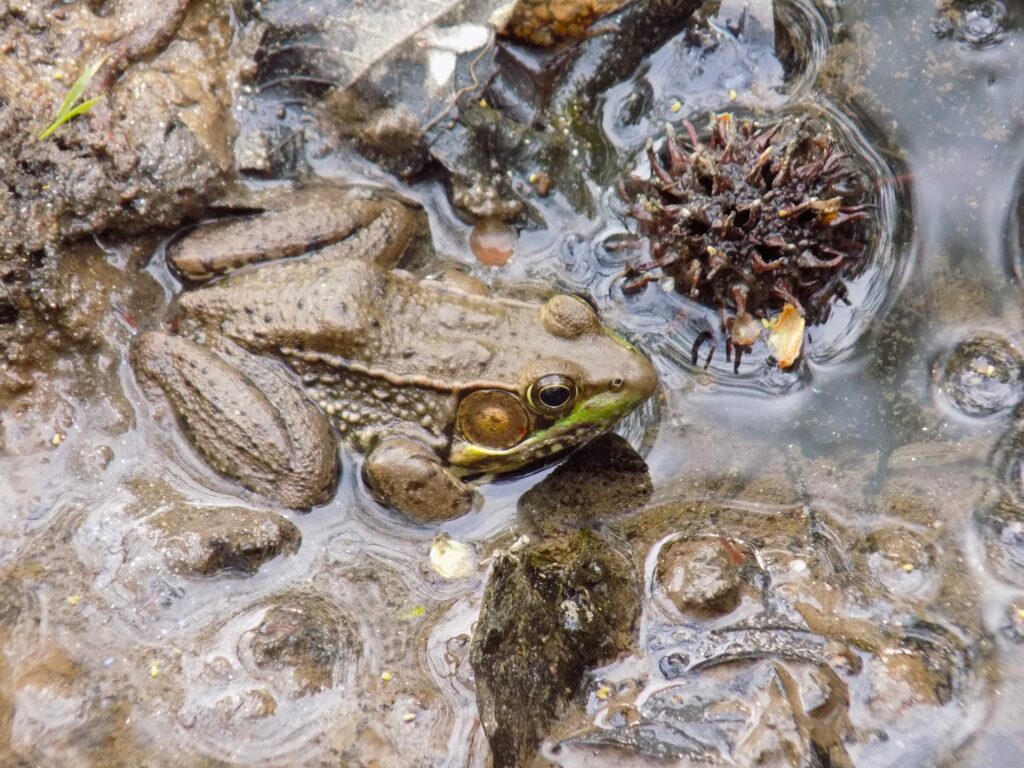

This week for Flora and Fauna Friday were listening in for the long-legged locals of genus Lithobates, the True Frogs.
The members of the genus Lithobates contains many of our most numerous and recognizable frogs. They’re designated as true frogs, with “true” here meaning something closer to “typical” or “normal”. Here in South Carolina we have nine species in the genus with eight in the Lowcountry. However, I’m just focusing today on the four species you’re likely to find on Edisto Island: Southern Leopard Frog (L. sphenocephala), Bronze Frog (L. clamitans clamitans), American Bullfrog (L. catesbeiana), and Pig Frog (L. grylio).
The Southern Leopard Frog is by far the easiest to identify, and probably also the easiest to find. They’re roughly three inches in length and have a distinctive pointed head, with their specific epithet “spenocephala” meaning “wedge-head”. They’re primarily bronze in color and sometimes a pine-green along the spine with two raised, ivory-white lines down each side of their back and small dark-brown blotches across the body. These blotches giving it the “leopard” part of the common name. The call of our Leopard Frog is unmistakable, sounding like someone flicking the teeth on a plastic comb except low pitched and variable in tone. Leopard Frogs can be found in pretty much any semi-permanent body of freshwater in the Lowcountry and are notably more tolerant of salt intrusion than most frogs.
The Bronze Frog is even more common than the Leopard Frog in certain areas and is the subspecies of the Green Frog found here in the Lowcountry. Bronze Frogs are usually about three to four inches in length and much smaller and browner than the Green Frog of the upstate. They have a bit of a point to their snout and raised ridges along the sides of their back. They’re an almost uniform dull-mocha or bronze color with a pale line above their lip. Their call is an easily recognized single note that can only be described as someone plucking a banjo string. Bronze Frogs can be found in much the same habitats as Leopard Frogs but seem to be a little more partial to woodlands and don’t have the same tolerance for salt.
The American Bullfrog is our third most common True Frog and definitely the largest, occasionally reaching eight inches in length but usually closer to five or six. Bullfrogs have a blunt snout, smooth back, and are generally a three color palette, with a sometimes mottled back and legs in brass, bronze, or green, a green face, and yellow throat. The song of the Bullfrog is a simple but loud and resonant “moo”, hence the “bull” part of the common name, or sometimes their call is a punctuated “jug-o-rum”, repeated once about every second. They’re commonly found in pretty much every permanent freshwater wetland, especially ponds.
The Pig Frog is our least abundant of the True Frogs but not a rare species. They’re about the same size as a Bullfrog at around four to five inches in length but tend to be smaller. The Pig Frog is similar in appearance to the Bullfrog too, with a smooth back (no ridges) and greenish coloration. However, the Pig Frog has a pointier snout and is usually a more uniform brass-green color across the body with small black spots. The serenade of the Pig Frog is, you guessed it, like to oink-ing of a pig. Usually just one or two “oinks” at a time but sometimes many. They’re found in permanent wetlands, usually large ponds, open swamps, and freshwater marshes. Pig Frogs are often easy to hear but hard to see, given their preference for swampy waterbodies.


This week for Flora and Fauna Friday it’s a magenta flower of the morning marsh, Saltmarsh Morning-Glory (Ipomoea sagittata).
Saltmarsh Morning-Glory is an herbaceous twining vine belonging to, unsurprisingly, the Morning-Glory family, Convolvulaceae, and shares much of the same characteristics with our other Morning-Glories. Salt Marsh Morning-Glory is a perennial vine that dies back to its roots each winter. It climbs by twining around surrounding grasses, forbs, and shrubs and generally stays fairly low to the ground, sometimes growing like a sparse groundcover. Its leaves are narrow and sharply pointed like an arrowhead, which is the origin for its specific epithet “sagittata” meaning “arrow-shaped”. The flowers of Saltmarsh Morning-Glory are that characteristic funnel-shape of Morning-Glories and, from the front, present a roughly three inch circle of magenta, deepening in richness towards the center. Morning-Glories get their name from their flowers, which open in the morning and wilt in the heat of the afternoon. This species of Morning-Glory is also easily recognized by its preference for sandy, moist soils along brackish impoundments and the fringes of tidal creeks. Sometimes even growing out into salt scrub meadows.
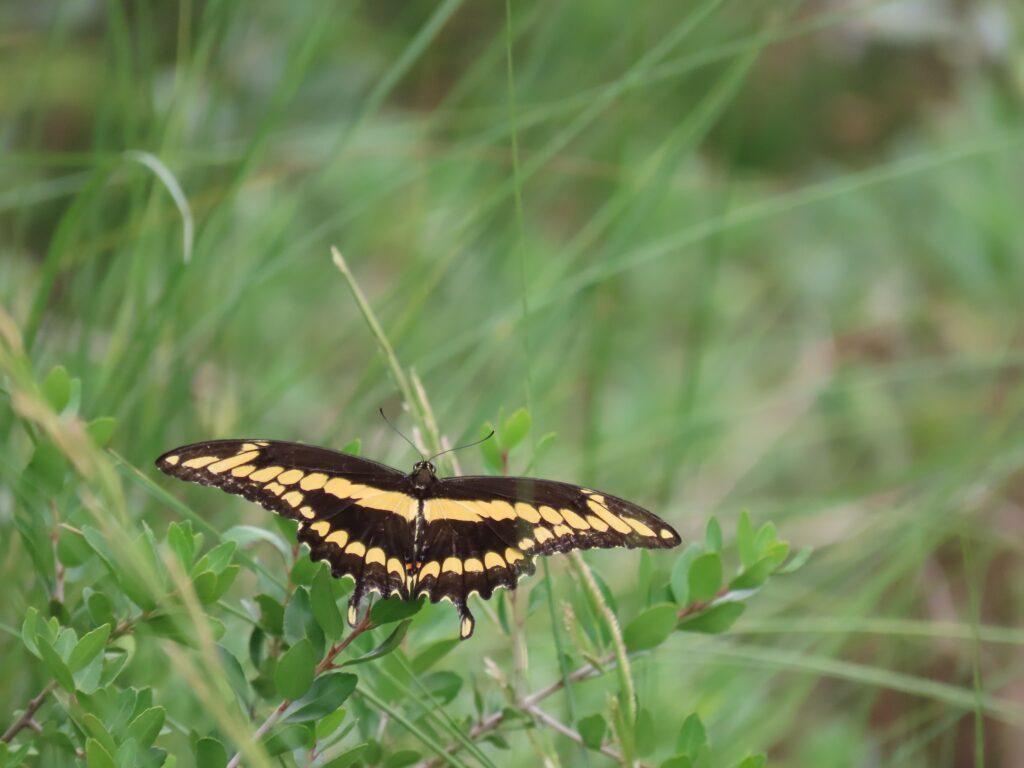

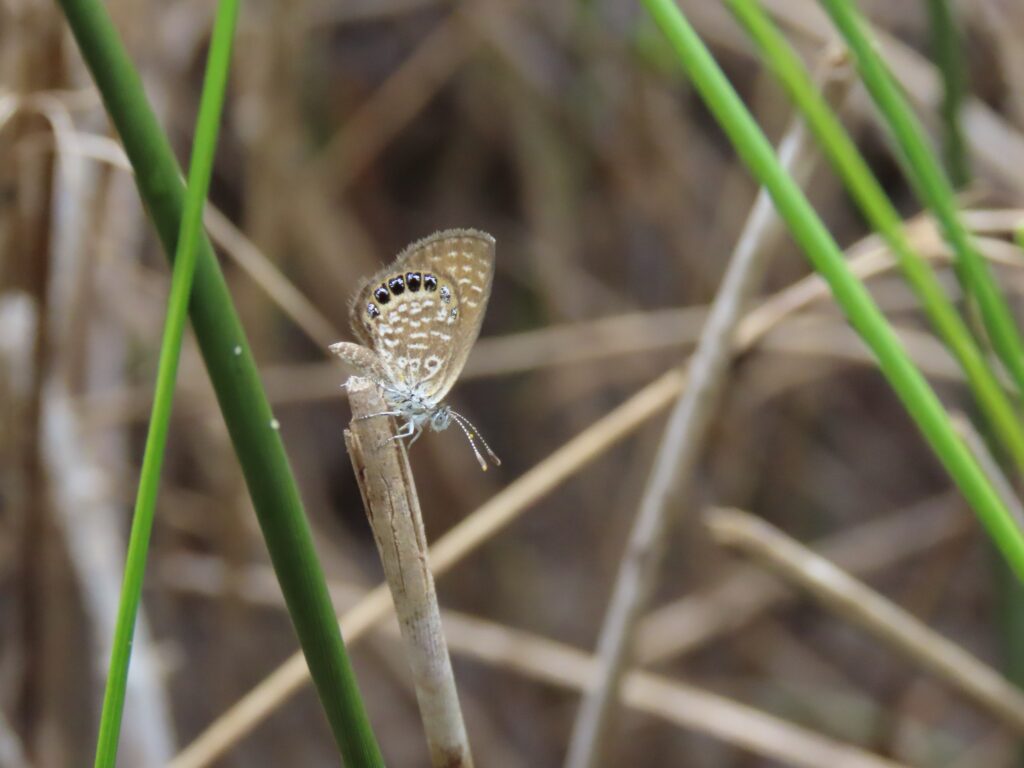
This week for Flora and Fauna Friday we have a pair of unrelated but extreme exemplifying butterflies, the Eastern Giant Swallowtail (Papilio cresphontes) and the Eastern Pygmy-Blue (Brephidium pseudofea).
The reason why I’ve decided to shine a spot light on these two unrelated species today is because they represent the full range of physical size for our native butterfly species here in South Carolina. Additionally, their preferred natural habitats overlap quite well and you may very well see both species on the same day in the same place. Let’s start with the little one.
The Eastern Pygmy-Blue is a miniscule butterfly in the Hairstreak family. Usually it’s no bigger than a fingernail. Its underside scales are overall a warm golden-brown down the wings, blending into a silvery-white body. Across the underwing are dashes of white and a trailing edge on the hindwing of six small black and metallic-silver eyespots. The upperside of females is a cinnamon-brown and males a darker shade of cinnamon but with a flash of sapphire blue over and along the body. The Pygmy-Blue can be a troublesome butterfly to find due to its itty-bittiness and preferred habitat, salt flats. The Eastern Pygmy-Blue caterpillar hosts on just as select few species of glassworts and so the adults can only be found in and around these sunny, soggy, sea-breezed, salt-saturated sand-lands. Adults begin flying in late spring and continue through to the end of summer in coastal South Carolina.
The Eastern Giant Swallowtail is a big honkin’ butterfly. They can grow nearly the size of your hand but are generally about six inches wide. Beyond their size, which dwarfs even our other swallowtails, they’re easy to identify by just their coloration. The upper surface of their wings is slate-black with a thick pastel-yellow line of blotches from one forewing tip straight through to the other and another line of yellow blotches running from the “wrists” of the forewings down where they make a “V” near the inner corner of the hindwings, just below a set of sky-blue and sunset-orange eyespots. From below they are even more distinctive, with the entire body and much of the wings being basted in a pure wash of butter-yellow. Through the center of the hindwing underside runs a series of powder-blue crescents and blood-orange blobs bordered with ink-black. The Eastern Giant Swallowtail is not a hard species to spot when you’re in the right place. They patrol the fringes of maritime forests and tidal creeks and are especially common along barrier islands and the Sea Islands. This is because they’re searching for or patrolling around their most prolific native host plant, Toothache Bush, which grows across the coast of the Lowcountry. The caterpillar of our Giant Swallowtail can also eat citrus leaves, and so they’re also a common visitor to orchards and coastal yards. Their caterpillar is easy to spot too. Not only is it big, it also has a distinctive color pattern of white, brown, and black blended together to create a perfect disguise as bird poop. This camouflage helps keep the caterpillars safe from avian predators but does make them stand out starkly against green foliage to the trained eye. Adult Giant Swallowtails fly from mid-spring until down into fall here in the Lowcountry.
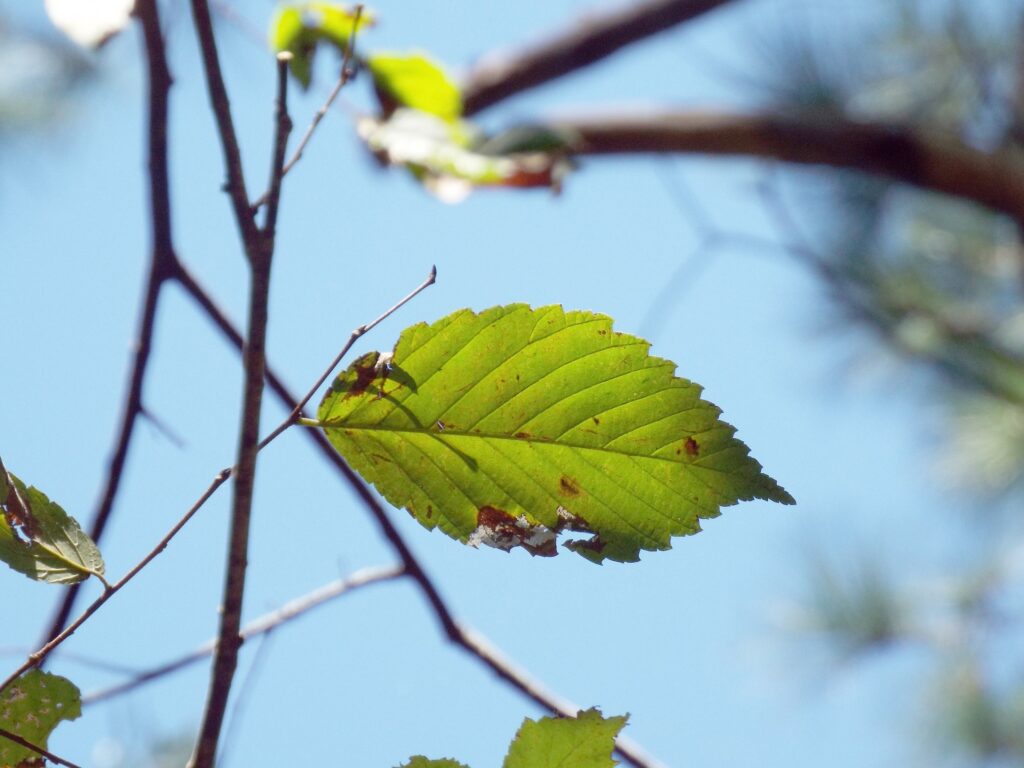
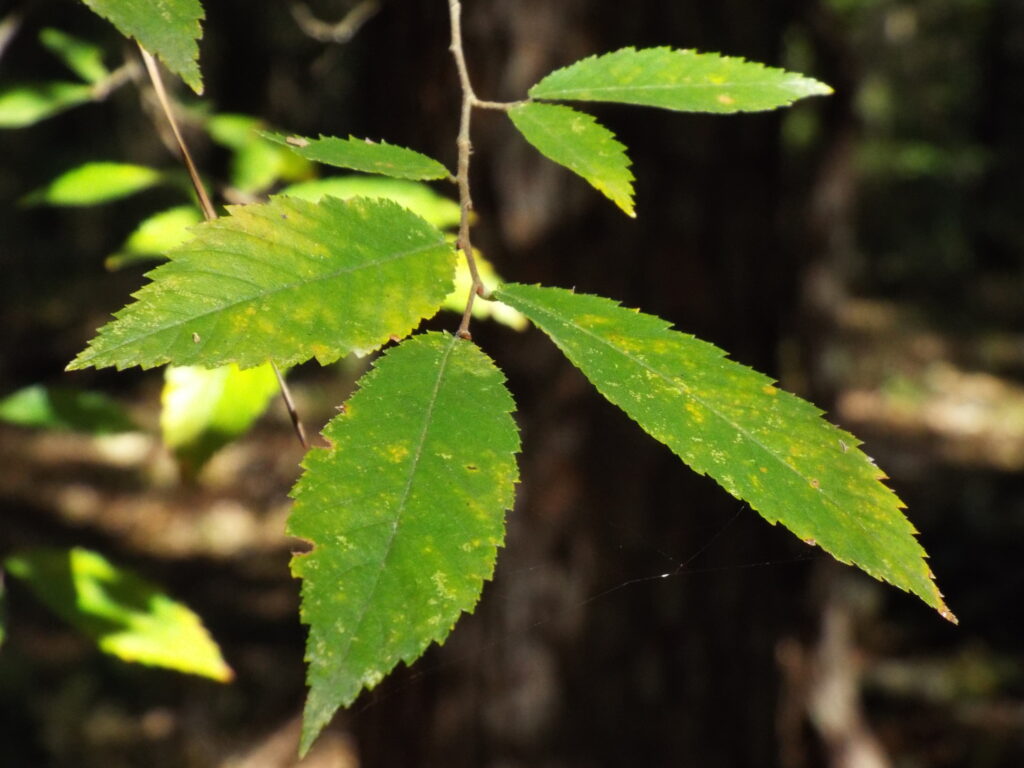

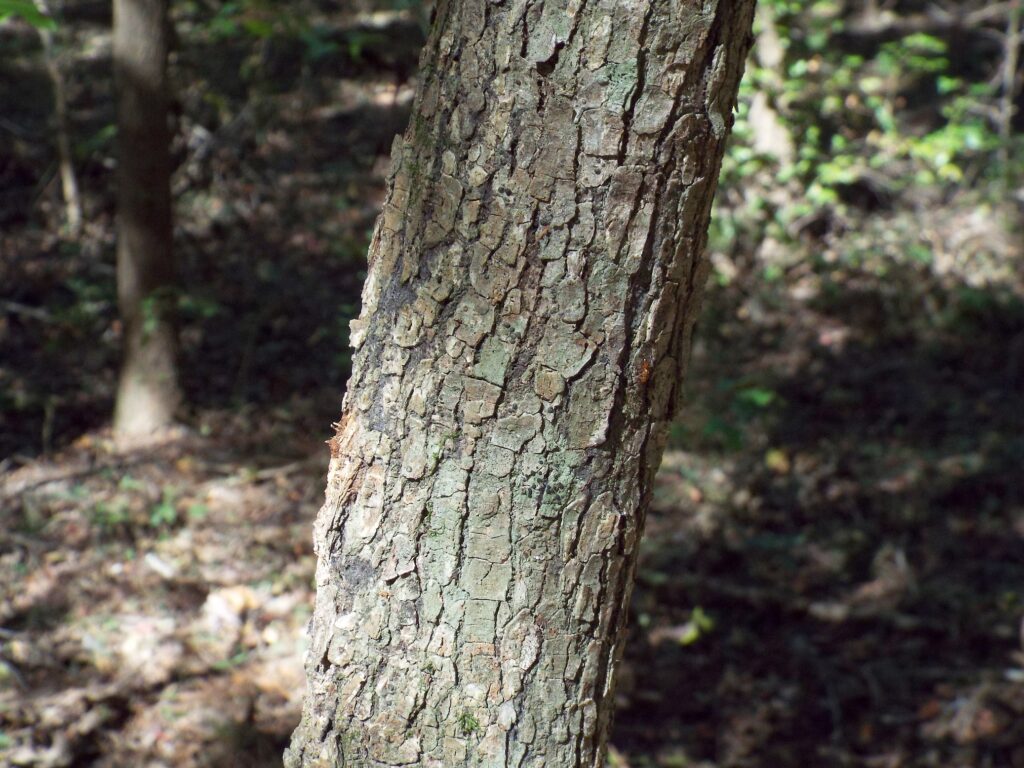
This week for Flora and Fauna Friday we’re simply going to be learning about our Elms, genus Ulmus.
Here on Edisto Island we have two native species of Elm, American Elm (U. americana) and Winged Elm (U. alata), and one exotic, Chinese Elm (U. parvifolia). All our Elms share a couple common characteristics. Elm trees tend to be about as wide as they are tall and, here in South Carolina, they maintain a compact height, usually not exceeding 50ft. All three of these elms also have a simple, elliptical leaf with prominently serrated margins and an alternate arrangement. The fruit of the tree is a dry winged seed called a samara. These samaras are compose of a single seed surrounded by a circular wing that catches the wind as the seed falls from the tree. To distinguish them by species, Chinese Elm is purely an ornamental exotic. It’s very common nowadays in urban parks, parking lots, and road islands but shows no characteristics of an invasive species in South Carolina. It has a very compact growth here in the Lowcountry, holds it small dark-green leaves throughout winter but sheds them in spring, and sports a beautiful calico bark of reds, grays, and yellows. Winged Elm is probably the easiest to spot. Its twigs, and the trunks of saplings, are flanked by broad, thin, corky wings of bark. Its leaves are small compared to American Elm. It is a fairly slow growing tree that demands full-sun and is most often found on field edges, clear-cuts, and stream banks. American Elm is the largest of the three by far, with a wide trunk covered in shaggy gray bark and a broad crown. Its leaves are roughly two to three inches in length and have the interesting characteristic of being asymmetrical at the base, with one side slightly longer. It prefers to grow along ditch edges, floodplains, and other rich, moist soils.
American Elm was once a massively popular landscape plant throughout the Eastern United States. However, the introduction of Dutch Elm Disease in the late 1920s caused a mass die-off of Elm trees across the country. Dutch Elm Disease is a fungal pathogen spread by beetles when they lay their eggs on Elm trees. The most prominent symptom is the death of upper limbs of the tree, eventually spiraling into the entire crown dying. Nowadays, very few Elm trees reach maturity before succumbing to the disease, leading to their relative rarity in modern forests. The American Elm was by far the hardest hit. The Winged Elm is also highly susceptible but its southeastern range is not as conducive to the spread of the disease. The ornamental Chinese Elm is highly resistant but still susceptible.